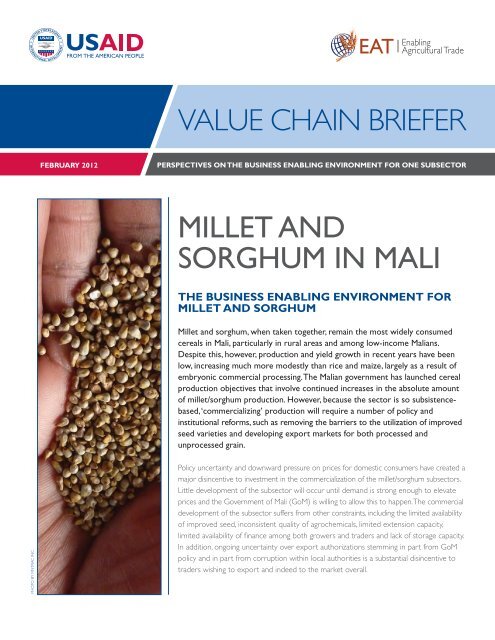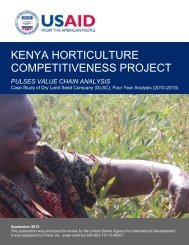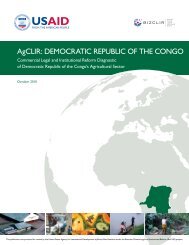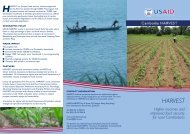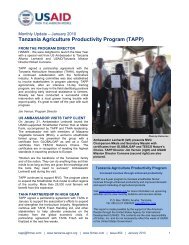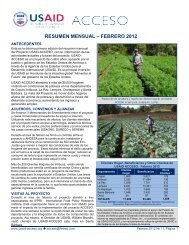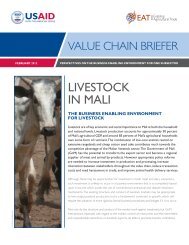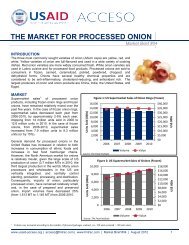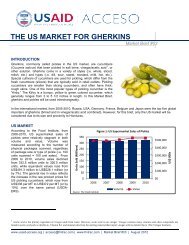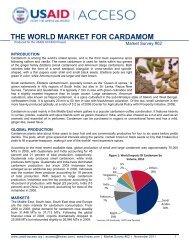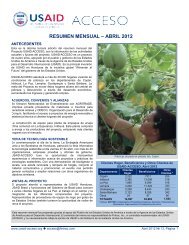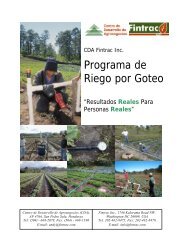Millet and sorghuM in Mali VaLue chaIn BrIeFer - Fintrac Inc.
Millet and sorghuM in Mali VaLue chaIn BrIeFer - Fintrac Inc.
Millet and sorghuM in Mali VaLue chaIn BrIeFer - Fintrac Inc.
Create successful ePaper yourself
Turn your PDF publications into a flip-book with our unique Google optimized e-Paper software.
PhoTo By FInTrac <strong>Inc</strong>.<br />
feBruarY 2012<br />
EAT Enabl<strong>in</strong>g<br />
Agricultural Trade<br />
<strong>VaLue</strong> <strong>chaIn</strong> <strong>BrIeFer</strong><br />
PersPecTives on The Bus<strong>in</strong>ess enaBl<strong>in</strong>g environmenT for one suBsecTor<br />
<strong>Millet</strong> <strong>and</strong><br />
<strong>sorghuM</strong> <strong>in</strong> <strong>Mali</strong><br />
The Bus<strong>in</strong>ess enaBl<strong>in</strong>g environmenT for<br />
milleT <strong>and</strong> sorghum<br />
<strong>Millet</strong> <strong>and</strong> sorghum, when taken together, rema<strong>in</strong> the most widely consumed<br />
cereals <strong>in</strong> <strong>Mali</strong>, particularly <strong>in</strong> rural areas <strong>and</strong> among low-<strong>in</strong>come <strong>Mali</strong>ans.<br />
despite this, however, production <strong>and</strong> yield growth <strong>in</strong> recent years have been<br />
low, <strong>in</strong>creas<strong>in</strong>g much more modestly than rice <strong>and</strong> maize, largely as a result of<br />
embryonic commercial process<strong>in</strong>g. the <strong>Mali</strong>an government has launched cereal<br />
production objectives that <strong>in</strong>volve cont<strong>in</strong>ued <strong>in</strong>creases <strong>in</strong> the absolute amount<br />
of millet/sorghum production. however, because the sector is so subsistencebased,<br />
‘commercializ<strong>in</strong>g’ production will require a number of policy <strong>and</strong><br />
<strong>in</strong>stitutional reforms, such as remov<strong>in</strong>g the barriers to the utilization of improved<br />
seed varieties <strong>and</strong> develop<strong>in</strong>g export markets for both processed <strong>and</strong><br />
unprocessed gra<strong>in</strong>.<br />
Policy uncerta<strong>in</strong>ty <strong>and</strong> downward pressure on prices for domestic consumers have created a<br />
major dis<strong>in</strong>centive to <strong>in</strong>vestment <strong>in</strong> the commercialization of the millet/sorghum subsectors.<br />
Little development of the subsector will occur until dem<strong>and</strong> is strong enough to elevate<br />
prices <strong>and</strong> the Government of <strong>Mali</strong> (GoM) is will<strong>in</strong>g to allow this to happen. The commercial<br />
development of the subsector suffers from other constra<strong>in</strong>ts, <strong>in</strong>clud<strong>in</strong>g the limited availability<br />
of improved seed, <strong>in</strong>consistent quality of agrochemicals, limited extension capacity,<br />
limited availability of f<strong>in</strong>ance among both growers <strong>and</strong> traders <strong>and</strong> lack of storage capacity.<br />
In addition, ongo<strong>in</strong>g uncerta<strong>in</strong>ty over export authorizations stemm<strong>in</strong>g <strong>in</strong> part from GoM<br />
policy <strong>and</strong> <strong>in</strong> part from corruption with<strong>in</strong> local authorities is a substantial dis<strong>in</strong>centive to<br />
traders wish<strong>in</strong>g to export <strong>and</strong> <strong>in</strong>deed to the market overall.
a strong reliance upon<br />
trust-based market<br />
transactions limits the<br />
potential markets for<br />
each buyer <strong>and</strong> seller,<br />
effectively segment<strong>in</strong>g<br />
the value cha<strong>in</strong> <strong>and</strong><br />
reduc<strong>in</strong>g its efficiency.<br />
2<br />
The availability of <strong>in</strong>puts for commercial production is limited. In particular, the quality of<br />
agrochemicals available to improve yields is compromised by a lack of enforcement of<br />
st<strong>and</strong>ards <strong>and</strong> labell<strong>in</strong>g procedures, while the availability of improved seeds is restricted by<br />
<strong>in</strong>adequate certification capacity <strong>and</strong> lengthy seed production procedures. The social<br />
stigma often associated with the purchase of seed may <strong>in</strong>hibit traditional growers but is<br />
unlikely to be a barrier to commercial production.<br />
Because millet <strong>and</strong> sorghum are produced ma<strong>in</strong>ly by smallholders <strong>and</strong> are rarely commercial<br />
crops, it is difficult for growers to access credit unless it could be made available aga<strong>in</strong>st a<br />
contract or on another more <strong>in</strong>novative basis. The same holds true for traders <strong>and</strong><br />
processors who have expressed difficulties <strong>in</strong> access<strong>in</strong>g the f<strong>in</strong>ance necessary to purchase<br />
the crop <strong>in</strong> economic volumes. The neutral attitude of the GoM to the development of<br />
millet <strong>and</strong> sorghum has not helped the commercialization process, especially when<br />
compared with Initiative Riz. There is a lack of extension capacity for these crops, <strong>and</strong> there<br />
is limited <strong>in</strong>terest on the part of the government <strong>in</strong> public-private partnerships, such as a<br />
case <strong>in</strong> which local authorities might organise growers <strong>and</strong> collaborate with private sector<br />
processors to provide the necessary extension <strong>and</strong> grower management.<br />
Quality st<strong>and</strong>ards are poorly def<strong>in</strong>ed <strong>and</strong> enforced, lead<strong>in</strong>g to confusion <strong>and</strong> opacity with<strong>in</strong><br />
the market. This usually works to the detriment of producers, but also contributes to an<br />
overall failure <strong>in</strong> terms of price signals <strong>and</strong> the efficient use of productive resources. The<br />
strong reliance upon trust-based market transactions limits the potential markets for each<br />
buyer <strong>and</strong> seller, effectively segment<strong>in</strong>g the value cha<strong>in</strong> <strong>and</strong> reduc<strong>in</strong>g its efficiency.<br />
KeY vcclir recommendaTions<br />
a comprehensive <strong>Mali</strong> VcClir analysis, complete with prioritized recommendations<br />
for reform, will be made publically available <strong>in</strong> January 2012. the follow<strong>in</strong>g is an<br />
illustrative list of VcClir recommended actions that promise to improve the<br />
bus<strong>in</strong>ess climate for firms <strong>in</strong> the millet <strong>and</strong> sorghum <strong>in</strong>dustry:<br />
• liberalize the domestic <strong>and</strong> export markets for gra<strong>in</strong>s <strong>and</strong> flours to enhance<br />
commercial development <strong>and</strong> <strong>in</strong>creased production. The restrictive policy of<br />
GoM regard<strong>in</strong>g domestic prices of cereals constra<strong>in</strong>s the development of a viable<br />
commercial subsector. The export market is similarly constra<strong>in</strong>ed by <strong>in</strong>termittent <strong>and</strong><br />
unpredictable restrictions on the export of gra<strong>in</strong>s.<br />
• <strong>in</strong>crease clarity <strong>and</strong> ultimately reduce gom <strong>in</strong>tervention <strong>in</strong> <strong>in</strong>put markets.<br />
The lack of predictability <strong>in</strong> GoM <strong>in</strong>terventions <strong>in</strong> the price of <strong>in</strong>puts for millet <strong>and</strong> sorghum<br />
currently generates uncerta<strong>in</strong>ty <strong>and</strong> may well reduce rather than <strong>in</strong>crease subsector<br />
productivity. a clearer non-<strong>in</strong>terventionist position would allow farmers to allocate their<br />
resources most efficiently between food security <strong>and</strong> cash crop production. on the<br />
other h<strong>and</strong>, <strong>in</strong>creased emphasis on the enforcement of st<strong>and</strong>ards <strong>and</strong> labell<strong>in</strong>g for<br />
agrochemicals, the development of accreditation st<strong>and</strong>ards <strong>and</strong> procedures for seed<br />
certification, <strong>and</strong> the development of a second tier of quality declared seed, would all<br />
help to overcome <strong>in</strong>put constra<strong>in</strong>ts to production.<br />
VcClir briefer: <strong>Millet</strong> <strong>and</strong> <strong>sorghuM</strong> <strong>in</strong> <strong>Mali</strong>
• <strong>in</strong>crease the availability of f<strong>in</strong>ance for gra<strong>in</strong> traders. Stimulation of the commercial<br />
subsector is constra<strong>in</strong>ed by a lack of f<strong>in</strong>ance especially amongst traders. <strong>Inc</strong>reased<br />
competition between traders with more liquidity would benefit both growers <strong>and</strong><br />
consumers, s<strong>in</strong>ce it would substantially reduce annual price fluctuations. <strong>Inc</strong>reased emphasis<br />
upon the development of large-volume storage capacity <strong>and</strong> the consequent use of<br />
stored gra<strong>in</strong>s as collateral (for both traders <strong>and</strong> producers) is one way <strong>in</strong> which credit<br />
facilities could be made more accessible to the subsector.<br />
• reduce transaction costs between producer <strong>and</strong> consumers by <strong>in</strong>creas<strong>in</strong>g<br />
vertical <strong>in</strong>tegration with<strong>in</strong> the subsector. one key aspect that would <strong>in</strong>crease<br />
subsector efficiency is the coord<strong>in</strong>ation of gra<strong>in</strong> production to achieve the consistency<br />
of volume <strong>and</strong> quality necessary to be attractive to large-volume traders <strong>and</strong> processors.<br />
The direct payment of quality <strong>and</strong> volume premiums to growers with<strong>in</strong> a vertically<br />
<strong>in</strong>tegrated product supply scheme (developed either on an out-grower basis or through<br />
contract farm<strong>in</strong>g) would result <strong>in</strong> improvements <strong>in</strong> quality <strong>and</strong> volume. This could be<br />
achieved through a public-private partnership <strong>in</strong> which government would coord<strong>in</strong>ate<br />
growers <strong>in</strong> terms of <strong>in</strong>puts, extension <strong>and</strong> production, while the private sector would<br />
address the issues of <strong>in</strong>dustrial process<strong>in</strong>g <strong>and</strong> market<strong>in</strong>g.<br />
• facilitate regional export opportunities through improved ma<strong>in</strong>tenance of<br />
major trunk <strong>and</strong> long distance feeder roads, <strong>and</strong> <strong>in</strong>formation <strong>and</strong> export promotion<br />
centers <strong>in</strong> markets. The Dncc’s export promotion unit should be given free re<strong>in</strong> to<br />
promote all competitive exports without regard for current trade policy, <strong>and</strong> should<br />
monitor unmet export dem<strong>and</strong> for <strong>Mali</strong>an products, <strong>in</strong>clud<strong>in</strong>g all cereals.<br />
• improve access to better quality seeds by develop<strong>in</strong>g Quality Declared Seed <strong>and</strong><br />
strengthen<strong>in</strong>g the capacity of private <strong>and</strong> SSn certification agencies to certify seeds for<br />
quality, purity, <strong>and</strong> variety <strong>in</strong> a transparent manner.<br />
usaid – enabl<strong>in</strong>g agriCultural trade (eat) ProJeCt<br />
PhoTo By FInTrac <strong>Inc</strong>.<br />
3
nate Kl<strong>in</strong>e, Chief of Party<br />
eat/f<strong>in</strong>trac<br />
202.621.7349<br />
nkl<strong>in</strong>e@f<strong>in</strong>trac.com<br />
this report is based on f<strong>in</strong>d<strong>in</strong>gs from the VcClir <strong>Mali</strong> diagnostic published <strong>in</strong> March 2012, funded by usaid/<strong>Mali</strong>,<br />
<strong>and</strong> was produced by usaid’s enabl<strong>in</strong>g agricultural trade (eat) Project, <strong>and</strong> implemented by f<strong>in</strong>trac <strong>in</strong>c.,<br />
a worldwide leader <strong>in</strong> generat<strong>in</strong>g rural <strong>in</strong>come <strong>and</strong> food security.<br />
disClaiMer: the views expressed <strong>in</strong> this publication do not necessarily reflect the views<br />
of the united states agency for <strong>in</strong>ternational development or the united states government.<br />
www.eatproject.org<br />
deanna gordon, Cotr<br />
usaid/bfs<br />
202.712.0623<br />
degordon@usaid.gov


